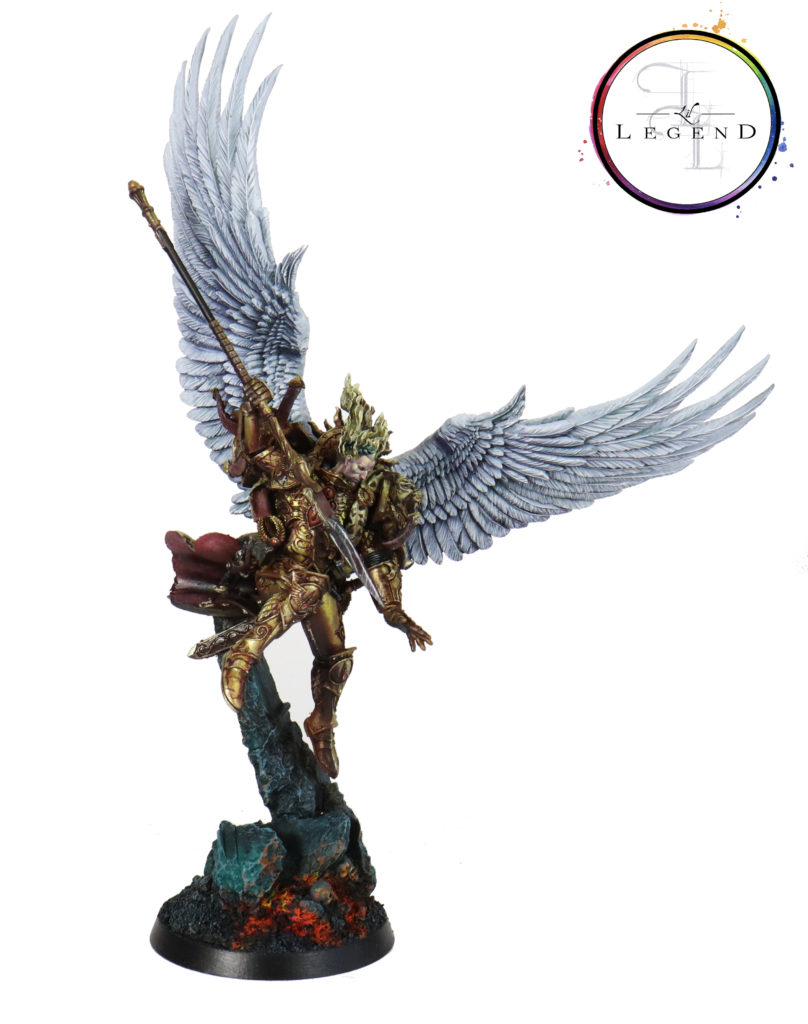
Guest author and fellow Blood Angel nut Captain Morgan has been using his time productively on lockdown playing video games (haven’t we all). Without further ado, Captain, the ship is yours…
With quarantine going on and games played on the tabletop at an all-time low, I’ve had to get creative a bit with how I get my Horus Heresy fix. Aside from some big hobby projects, including some customized Dawnbreakers and my Thunderhawk project, I’ve been putting some time into the Horus Heresy: Legions card game on mobile. It helped that they recently released content that included the IXth Legion, and I can’t seem to avoid spending time and money on things that are Blood Angels related, even if it is a mobile game.
You don’t want to know how many times I got card packs with Kyriss before I eventually got to the Angel…
Of course, my heart is still set on the tabletop. I’ve got a campaign currently on hold in my area due to COVID-19 restrictions, and so while playing the card game I was struck by one of the unique abilities given to the Blood Angels that I wanted to try to bring to the table. The ability is called “Requiem” and it triggers when a card next to the card with this ability dies. The effect can vary between cards, but it generally comes in the form of a stat boost of some kind in either health or attack power. I like how this ability captures some of the theme of the Blood Angels, particularly as Sanguinius gets upgraded when units die next to him – the fury over the death of his sons causing him to ascend to even more dangerous heights. His ultimate form, “The Great Angel,” unlocks after enough friendly infantry die around him, giving him a boost to health and permanent increases to damage as units continue to die around him. I’ve had opponents who simply quit as soon as I unlock this form.
Suffice to say (because an easy look at my ranking will tell you I’m no master at card games), that I really liked how the mechanic worked in the card game, and I began to think about how to translate this onto the tabletop. A Rite of War seemed the right place, so I began cracking out some bonuses, requirements, and limitations to fit in with this mechanic. I wanted something that gave a useful benefit, felt narratively appropriate, and kept the possibility of victory open, unlike Day of Sorrow. Here’s what I came up with:
Blood Angels Unique Rite of War: Requiem of Angels
After the events of Signus Prime and the knowledge of the great betrayal of Horus and the other legions became widespread among the legion, an anger kindled in the heart of the surviving warriors. This would at times manifest itself in battle as they saw their brothers fall around them, remembering the burning wrath they experienced when witnessing the Angel wounded by the daemons’ foul sorcery. Warriors with a tendency towards this new wrath were put together into Requiem formations at the suggestion of the Ofanim, who were at their capacity trying to manage the fallout of this new war’s effect on legion morale.
This new formation proved to be an effective combat tool, though it was difficult to control and often led to an overextension of combat forces. Few enemies would still have the means to take advantage of this weakness, however it was decided that defensive campaigns should be left to more disciplined formations. Little did the legion know what this new battle lust would presage, and how it would impact the legion in the millenia following the siege to come.
Effects
- Succumb to Vengeance: Any infantry and dreadnoughts with the Legiones Astartes (Blood Angels) special rule in this Rite of War gain the Furious Charge and Fear special rules when another friendly infantry or dreadnought unit within 6” with the Legiones Astartes (Blood Angels) special rule in this Rite of War is killed, is caught in a sweeping advance, or is otherwise removed from play. Dreadnought models additionally gain the Rage special rule. Units under this effect are considered as having “Succumbed to Vengeance” for the rest of the game. This effect does not trigger when an eligible friendly unit from this Rite of War flees off the table due to failing a morale test, or when friendly tanks, drop pods, flyers, or super-heavy vehicles included in this Rite of War are destroyed. Use an easily identifiable token or marker to indicate which unit(s) have succumbed to vengeance.
- Lex Talionis: Characters with the Legiones Astartes (Blood Angels) special rule in this Rite of War that are killed in a challenge may make a single attack before being removed from play. This attack occurs at initiative step 1 and may only be directed at the enemy model they are currently engaged in a challenge with.
- Angel of His Pure Wrath: If Sanguinius is included in this detachment, he loses the Angelic Presence special rule and gains the following special rule instead:
- Pure Wrath: Sanguinius gains a permanent +1 to his attacks characteristic for every infantry and dreadnought unit with the Legiones Astartes (Blood Angels) special rule in this Rite of War that dies while within 6” of his model.
Limitations
- Wardens of the Damned: A Chaplain Consul must be taken as a compulsory HQ choice in this Rite of War.
- Nightmares of the Dead: At least two dreadnought models must be included in an army that uses this Rite of War. For the purposes of this Rite of War, dreadnoughts are considered to have a leadership of 9.
- Seeing Red: Units that have Succumbed to Vengeance suffer a -1 penalty to leadership and cannot be pinned. Additionally, any unit that has Succumbed to Vengeance that does not include a Chaplain or Sanguinius must take a leadership test at the start of the owning player’s movement phase. Units that pass this test may act as normal. Units that fail the test must move their maximum movement distance towards the closest visible enemy unit and must declare a charge in the assault phase if eligible to do so. Units who have moved in this way may not make any voluntary action (such as shooting rapid fire or heavy weapons) that would prevent them from declaring a charge later that turn.

This Rite of War is admittedly a bit wordy, but I’m a technical writer by trade and I wanted to make sure the wording lined up with the intent as closely as possible. Succumbing to Vengeance is supposed to be both a blessing and a curse, something that reflects on the inherent duality that is a core theme to the legion. While it helps units deliver damage and gives them a fearful aspect, you also run the risk of losing control of some of your units. This means that taking units of heavy weapons or stationary firing platforms like quad mortars becomes a risky proposition if they are deployed close to other units. The negative to leadership – showing how much they are starting to lose control – also means that your units are at a greater risk of getting caught in a sweeping advance or losing your nerve due to heavy shooting. Being immune to pinning should help keep enemies from controlling your movement too much with pinning fire, but at the cost of the potential cover benefit that pinning provides.
Long-time Blood Angels players may recognize some nods to some old rules from 3rd edition sneaking their way in here. Units that succumb to vengeance act as proto-Death Company and so I included the requirement for a Warden (chaplain) as something that both makes you invest in some strong leadership, and also gives you a chance to control your warriors a bit more, much like Chaplains did for Death Company in 3rd edition.
Additionally, since the strength buff from Furious Charge isn’t as useful on dreadnoughts, I gave them Rage as well. By requiring two models, I’m giving players the chance to use either a talon of dreads or take different kinds. The benefits of this Rite of War focus on aggressive, combat-oriented armies, but this still leaves spots open for Deredeo or Mortis dreadnoughts. Since the quantity of ranged fire support will likely be lesser as a result of the potential unreliability of ranged squads, I wanted the dreads to hit a bit harder in combat. For those with a mighty need to have reliable shooting, there are plenty of tanks that can fill that role. I considered limiting heavy support choices or tanks, but I feel that the legion’s own limitations on vehicles fulfills that need adequately.
Anyway, let me know what you think of this Rite of War and if you would ever consider using it in your games. Is it too strong? Too weak? Too situational? Too wordy? I’d love to hear your feedback. You can get a hold of me at my Facebook page: Captain Morgan’s Librarius. Stop by and check in on some of my other projects, including the massive Thunderhawk project I’m neck-deep in.
Cheers!
Captain Morgan


